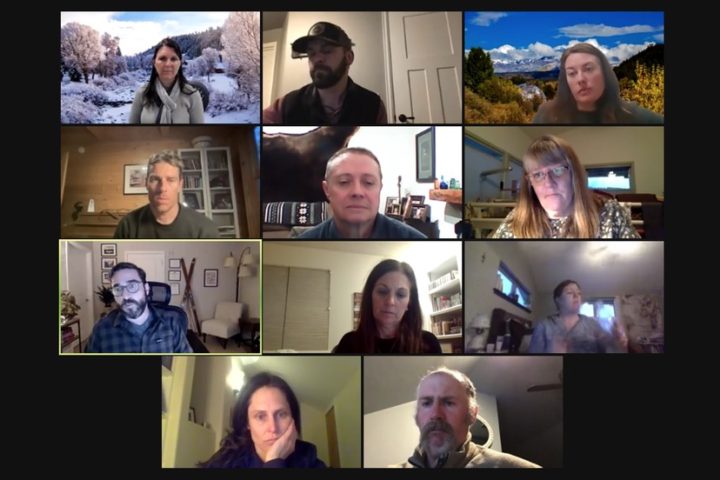At the end of Part Three, yesterday, I expressed my opinion that the Denver-based real estate experts from CBRE who are now advising our Pagosa Springs Town Council didn’t offer any valuable insights into the Council’s highest real estate priority — affordable housing — during a January 28 work session held via Zoom.
But near the conclusion of the work session, the lead CBRE expert, Karlen Beitman, did manage to re-direct the conversation — momentarily, at least — to the subject of ‘Public Private Partnerships’. “P3s”. The provision of special subsidies or publicly-owned assets to private developers, to encourage development.
Mr. Beitman smiled as he spoke:
“The other bucket is what we call ‘development advisory’ for P3s. I mean, the term ‘P3’ is so… uh… is so universal and is used in a variety of different ways. Really, what we refer to it as, is a partnership between a public and a private entity, and that’s it. It doesn’t necessarily have to do with specific revenue goals or specific types of assets. But really, what we see a lot of our municipal clients looking for, is development advisory, for… how do they optimize a certain asset that they have.
“So, for example, in the [Town Comprehensive Plan] one of the themes is utilizing P3s to incentivize or accelerate development when a town owns a property next to a developing area. I think one of those obvious pieces is, especially in the recent news, is about the Springs Resort development, and the fact that these Town-owned property that’s adjacent there.
“So, you know… I guess my question is… I know that there are a couple of different economic development tools — the [Urban Renewal Authority] and now that the rezoning has occurred… I’m curious what the Council and Mr. Mayor opinions are, of what role you might play in helping to advance that development… not just from a municipality perspective, but also from being a landowner that’s adjacent.
“Is that something that is of interest to explore, how the Town might play a role in that? A bigger role?”
A rather heavy silence settled over the Zoomed council.
Listening back to the audio recording, I counted 10 seconds before any Council members offered an answer on Mr. Beitman’s questions. That’s actually a relatively uncomfortable period of silence (in my opinion) to follow a question during an active, large group discussion. Perhaps Mr. Beitman also sensed the Council discomfort?
Finally, Council member Mat deGraaf laughed.
“Yeah, I think the answer — I can see on everyone’s faces — you asked a really big question that I don’t think any of us have an answer to.”
No one else spoke. Another awkward period of silence.
So, Mr. Beitman answered the question himself. “Well, I would say that it could be a recommendation that we make… um… to the Town, to say, ‘Here could be a couple of ways to leverage your position as a land owner, to this adjacent property, as it relates also to the fact that it’s a theme of the Comprehensive Plan.
“So I think maybe we can present it in a way that kind of describes some options, kind of like how we’re talking about strategies with affordable housing. Is that a fair… step?”
Another short silence. Then Council member Nicole Pitcher answered succinctly, “Yes.”
Mr. Beitman smiled. “Excellent.”
I suspect, listening back to this audio recording, that the Town Council was surprised by Mr. Beitman’s fascination with the proposed Springs Resort development — a highly controversial proposal, locally, considering that an overwhelming majority of Town voters recently approved a Home Rule Charter amendment to give the voters more control over large tax subsidies the Town’s new Urban Renewal Authority might propose in the future.

A couple of comments. Yes, the Town does own property adjacent to 27 acres of vacant property owned by developer Jack Searle — namely, the property on which the Town Hall and the Community Center sit… and the Town also owns the San Juan wetlands west of Town Hall. The wetlands parcels are in a conservation easement, created to ensure that no future development would destroy the wetlands.
Mr. Searle recently sold about half of his 27 acres to the Springs Resort partners, after convincing a majority of the Town Council that his vacant land qualifies under Colorado law as “dangerous blight,” and is therefore eligible for massive tax subsidies. Although four Town Council members accepted Mr. Searle’s claim of “dangerous blight”, it would appear that the Town electors rejected his claim by a 3-to-1 margin at the polls.
Yes, when the Town staff and consultants revised the Town Comprehensive Plan in 2018, they designated the development of Mr. Searles’ vacant property as a “catalytic project.”
Some of us studied this “catalytic project” during the solicited creation of the Urban Renewal Authority, and noted that it included not a single affordable housing unit on 27 acres of property, and that it proposed a commercial landscape of tourist industry businesses — the type of businesses most likely to pay substandard wages and thus create an even more desperate need for affordable housing in our community.
The voters, last July, recognized that economic mismatch — the proposed tax-subsidized creation of luxury housing accompanied by low-wage jobs — and overwhelmingly approved Ballot Question A, to prevent the Town Council from handing out huge tax subsidies without voter authorization.
We will also note that the Town Comprehensive Plan makes 363 recommendations for improving Town policies and regulations, only one of which mentions the Springs Resort as a “catalyst project”.
At least 40 of the Comp Plan recommendations concern affordable housing.


